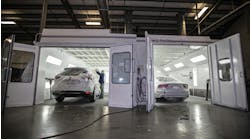Do you know the range in car count you want onsite to maximize your shop’s throughput, touch-time, cycle time, and profitability? You probably know intuitively when the shop feels too empty or too full, but if you haven’t done a little math to more carefully calculate where the “sweet spot” is, your business could be suffering for it.
I’d like to suggest one model for this calculation that demonstrates the value of going through the exercise of figuring this out. For this example, let’s say ABC Collision has nine technicians, each working 40 clock hours a week at 150 percent efficiency, meaning they are each producing 60 labor hours a week, or 12 labor hours per day. Combined, the nine are producing 108 labor hours per day.
For purposes of simplicity, let’s say each repair order at the shop averages 20 labor hours. That means if there’s only one car in the shop, work produced per day is only going to total 20 hours, even though the technicians could produce more if there were more cars to fix. Even at five cars, that’s only 100 hours produced out of the potential 108. Clearly, that’s not optimal, even if the number of hours (20) produced per day per vehicle would be considered phenomenal.
At the other end of the spectrum, let’s say the shop has 41 cars onsite, or 820 hours of work in progress. The technicians are still capable of producing 108 hours a day, but I would argue that at some point this starts to decline. Think about what happens when your shop and lot are jam-packed, think 5:30 p.m. traffic in LA. There’s more time spent jockeying cars around, and the office can get behind on getting work orders out and supplements approved. In any case, under this scenario, the hours produced per day per repair order drops to about 2.5 (and I’ve seen many shops where that number is even under 2). So, I’d argue that as work in progress (WIP) increases beyond a certain point, it cuts into the shop’s performance metrics and profit. The idea of having so much WIP that a repairer’s throughput was reduced was first illustrated in a graph constructed by Kent Carlson of Ad Meliora Consulting.
So, if five cars is not enough WIP, and anything over 40 cars and 800 hours of WIP is too much for ABC Collision, let’s look at scenarios in between these two extremes. With 10 cars onsite, the shop is producing an amazing 9.5 hours per RO per day, but the overall thoughput is very low. But is 10 cars and 200 hours of WIP enough to ensure the technicians can produce the full 108 hours? Maybe not, because of potential delays with parts or supplement approvals on some of those cars.
But 25 or 30 cars onsite and WIP in the 400-600 hour range might be closer to the sweet spot. Check out the impressive hours produced per RO per day. (I will say I currently see more shops at 3 or 3.5 hours per RO per day than I do at more than 4 hours.) That shop is going to have amazing cycle time and touch-time metrics, making insurers and customers happy, and maximizing the shop’s profitability.
Adjusting WIP isn’t the only variable in this analysis; the shop could certainly adjust the number of labor hours its nine technicians can produce, and I’ll talk about ways to do that in a future column.
We have measured production capacity and seen repairers increase the number of hours they can produce by 20 percent or more just by removing the waste (excess WIP) in their repair centers. In our data table, we illustrate a 7 percent increase in hours produced when WIP is in that ideal 400-600 range, and recognize that the chaos and dysfunction when WIP exceeds 42 vehicle (840 hours) begins to reduce production capacity. Again, think rush-hour traffic.
There’s a more in-depth explanation of this concept at my company’s website (www.CollisionResourcesInc.com). I think too few shops take the time to understand the potential impact WIP has on a number of metrics – including profitability.
| No. of cars onsite | Work-in-progess (WIP) | Work produced per day | Work produced per day per RO |
| 1 | 20 | 20 hours | 20.0 hours |
| 10 | 200 | 108 hours | 10.8 hours |
| 25 | 500 | 116 | 4.3 hours |
| 29 | 580 | 118 hours | 3.7 hours |
| 33 | 600 | 116 hours | 3.6 hours |
| 42 | 840 | 107 hours | 2.6 hours |




